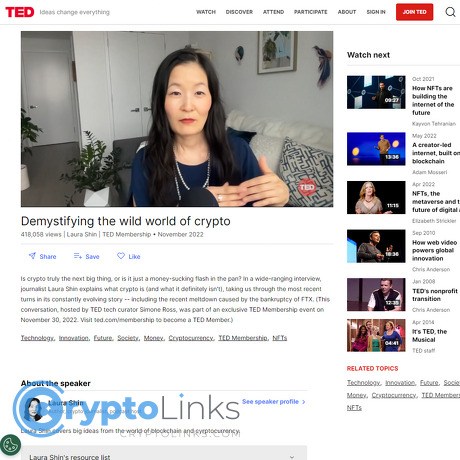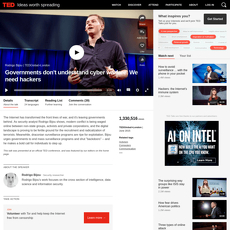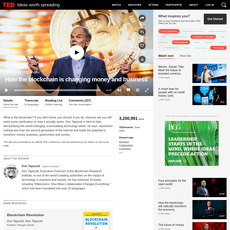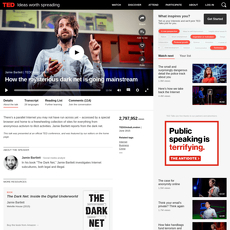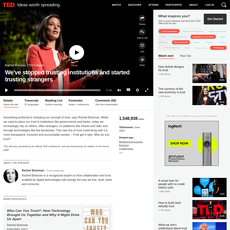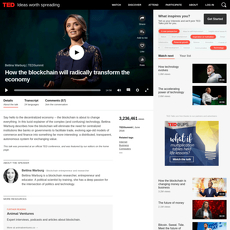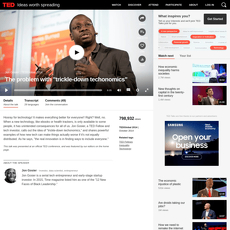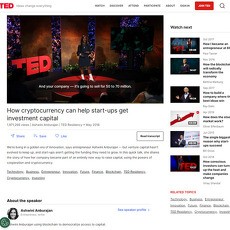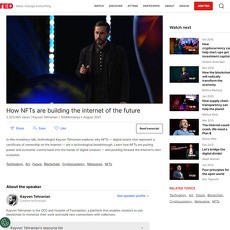Laura Shin: Demystifying the wild world of crypto Review
Laura Shin: Demystifying the wild world of crypto
www.ted.com
Laura Shin: Demystifying the Wild World of Crypto — Review Guide with Everything You Need to Know + FAQ
Still feel a bit lost after watching Laura Shin’s TED talk? Maybe you’re thinking, “I get the big idea… but what should I actually do now?” Great question. Stick with me—I’ll show you what’s signal, what’s noise, and how to turn that talk into a simple, safe plan.
Crypto is exciting—and confusing. Here’s why people get stuck.
Crypto is loud. There’s jargon, influencers, charts, scams, and a lot of “trust me bro” energy. Even after a great overview, most people still wonder how to start without getting burned.
- Too much noise: Every project claims it’s the future. Most aren’t.
- Jargon walls: Wallets, seed phrases, gas, keys… it feels like learning a new language.
- Real risks: Phishing, fake airdrops, rug pulls, and unsafe apps are everywhere.
- Analysis paralysis: BTC or ETH? Custodial or self-custody? Which wallet? Which exchange?
- Fear of missing out: Hype cycles push people into mistakes they wouldn’t make otherwise.
This isn’t just a gut feeling. Research backs it up: Pew Research found most Americans who’ve heard of crypto aren’t confident it’s safe or reliable, and Chainalysis shows that while scam revenue has fluctuated, phishing and social engineering continue to snare newcomers. The confusion is normal. The fix is a clear plan and a few guardrails.
Real example: A reader once set up a wallet, wrote down the 12 words, then stored them in Google Drive “just in case.” A week later, their funds were gone. The problem wasn’t crypto—it was a simple security mistake. This guide helps you avoid those.
What you’ll get here (in plain English)
I translate the big ideas from Laura Shin’s “Demystifying the wild world of crypto” into practical steps you can use today, without hype or technobabble.
- Clear takeaways: What matters from the talk—and what doesn’t.
- Simple safety: How to keep your money and data safe with a few easy habits.
- Action steps: A beginner-friendly path so you can learn by doing, not guessing.
- Straight answers: Quick, no-BS responses to the most common questions.
No trading calls. No “get rich” nonsense. Just the essentials that help you move forward confidently.
Why this review cuts through the noise
I’ve spent years testing wallets, exchanges, and crypto tools through bull runs and bear markets. I’ve watched projects launch with fireworks and vanish with a whimper. Patterns repeat, and so do avoidable mistakes. That perspective shapes everything here:
- User-first lens: Safety, clarity, and usefulness over hype.
- Reality checks: What actually works for beginners—step by step.
- Evidence where it counts: When I point out risks, I back them up with data and lived experience.
Promise: If a tip here can’t help you avoid a mistake or make a better decision, it doesn’t make the cut.
Watch the talk (keep this guide open)
Here’s the talk that started this: Laura Shin — Demystifying the wild world of crypto. Watch it now or later. This guide pairs with it either way.
Ready for the good stuff? In the next section, I break down what Laura actually says—in plain English—and show you how to use it. Want a one-minute filter to spot hype from value? Or the simple rule that would’ve saved thousands of beginners from common wallet mistakes? Let’s look into that next.
What Laura Shin actually says (in plain English)
Here’s the straight answer: the talk is about giving people control. Crypto’s promise is that you can move value and prove ownership without handing the keys to a bank, a platform, or a stranger on the internet. That freedom comes with responsibility—because once you’re the owner, there’s no “Forgot Password” button for your money.
Laura cuts through the buzzwords and shows why decentralization isn’t just a nerdy principle; it’s a safety feature. When no single company can freeze your account or rewrite history, the system can be fairer. But she also calls out the uncomfortable truth: crypto attracts scammers and speculators, and it’s easy to mistake noise for progress.
“Simple beats complicated. If you can’t explain a project to a skeptical friend in under a minute, pass.”
Who is Laura Shin?
She’s one of the few voices in crypto who built her reputation on careful research, not hype. If you’ve listened to the Unchained podcast or read The Cryptopians, you’ve seen her style: ask tough questions, present facts, and let readers think for themselves.
- Investigative receipts: She reported the likely identity of the DAO hacker in 2022 using on-chain forensics and interviews, a story that showed how transparent blockchains can help solve real cases.
- Years in the trenches: She’s covered crypto since before it was cool, which means she’s watched bubbles form—and pop.
- Balanced lens: She’ll explain why the tech matters and still tell you when something smells off.
The talk’s core message
Think of crypto as a new financial and internet layer that runs on public rails. It can expand access, cut fees, and make systems more transparent. It can also be chaotic, volatile, and full of traps. Your edge is education, skepticism, and basic security.
I like to frame it this way:
- Upside: Open access to money and markets, programmable finance, censorship resistance.
- Downside: Scams, speculation, technical mistakes that cost real money, and fast-moving risks.
Stay curious, but keep your guard up. That’s the vibe.
Key takeaways you should remember
- Wallets and keys are everything. Your private key is the proof you own your assets. Lose it, and you’re done. Trust someone else to hold it, and you open yourself to their failure. Need a reminder? When a major exchange collapsed in 2022, customer funds were trapped overnight—see the U.S. DOJ’s case against its founder for context: justice.gov.
- Tech vs. tokens. The underlying technology (like Ethereum’s smart contracts) is different from any token trying to ride the wave. Ask: is there real utility, or just a coin chasing price?
- Hype cycles attract scammers. Rug pulls and fake “opportunities” spike when prices rise. Chainalysis estimates illicit crypto transaction volume fell in 2023 compared to 2022, but ransomware earnings rebounded and scammers pivoted to new tactics—proof the risk never disappears, it just changes shape. Source: Chainalysis Crypto Crime Report 2024.
- Security and patience beat FOMO. Use 2FA, verify URLs, test with small amounts, and think in years—not days. After Ethereum’s transition to Proof of Stake in 2022, the network’s energy use reportedly dropped by ~99.95%—that’s long-term engineering, not a quick flip. Source: ethereum.org.
What you won’t get from the talk
- No trading signals. This isn’t a “buy now” video. It’s a compass, not a lottery ticket.
- No code lesson. You won’t learn how to write smart contracts here, and that’s fine—you’ll learn what matters before you risk a cent.
- No sales pitch. It’s a framework for thinking clearly in a noisy market.
So if the big picture makes sense, what exactly is a blockchain, how do confirmations work, and why does “not your keys, not your crypto” matter on a technical level? Keep reading—next up, I’ll break the concepts into simple, practical chunks you can actually use.
Breaking down the core concepts from the talk
I want you to feel confident, not confused. So let’s strip away the buzzwords and look at the building blocks that actually matter when you use crypto in the real world.
“Not your keys, not your coins.”
What is blockchain?
Think of a blockchain like a shared spreadsheet on the internet that nobody can secretly edit. New entries get added in time-stamped blocks, and every participant can verify the history. Once something is written, changing it is intentionally hard. That immutability is why blockchains are great for money, receipts, and clear audit trails.
Real example: if a charity accepts crypto, anyone can verify the donations hit the published address and see when funds move—no waiting for a PDF or “trust us” statement. That transparency beats email attachments and opaque reports.
- Public by default: Most mainstream blockchains are open ledgers—pseudonymous, not private by default.
- Append-only: You add new facts; you don’t overwrite old ones.
- Security by consensus: Many computers agree on the same history, so one party can’t rewrite it on a whim.
Coins vs. tokens
Coins (BTC, ETH) are native to their own blockchains. Tokens are assets issued on top of another chain (like ERC‑20 tokens on Ethereum—USDC, UNI, LINK). It’s like the difference between a nation’s currency (coin) and a gift card issued by a store that runs inside that nation (token).
- Coins: Pay network fees, secure the chain, and often act as reserve assets.
- Tokens: Can represent stablecoins, governance rights, points, or access—useful, but risk varies wildly with the issuer and code.
Practical tip: if someone pitches a token, ask what it actually does and who needs it. If the only answer is “number go up,” that’s not a use case.
Wallets, keys, and “not your keys, not your crypto”
Your wallet doesn’t hold coins—it holds private keys. Those keys prove you own the assets on-chain. Lose the keys and the assets are effectively gone. It’s that simple (and that unforgiving).
- Self-custody wallets: You control the keys. You’ll get a 12–24 word seed phrase. Write it down offline and keep it safe.
- Custodial accounts (exchanges, apps): They hold the keys for you—convenient, but you’re trusting their security and solvency.
Real example: when a major exchange failed, users who left funds there couldn’t withdraw. Those who held their own keys still had access. If you want a quick mental model: a custodial account is a bank; a self-custody wallet is a safe you own.
How transactions get confirmed
When you send crypto, you sign a message with your private key and broadcast it to the network. Then the network decides which transactions make it into the next block.
- Proof of Work (PoW): Miners expend electricity to propose blocks (Bitcoin). Secure, slower, predictable settlement.
- Proof of Stake (PoS): Validators lock up the network’s coin to propose/attest blocks (Ethereum today, many others). Energy-light, typically faster finality.
You’ll also pick a fee. Higher fees get processed sooner during busy times. On some networks, confirmations take seconds; on others, minutes. Finality is the point at which a transaction is practically irreversible—useful when sending larger amounts or settling trades.
Everyday example: moving a small amount of stablecoin on a low-fee chain can cost pennies and clear quickly. Moving a big BTC payment? Expect to wait for multiple confirmations before the recipient considers it final.
Why decentralization matters
Decentralization spreads power and responsibility. No single company can quietly freeze the ledger or rewrite history. The tradeoff? You get more freedom—but also more responsibility for your keys and security.
- Pros: Censorship resistance, fewer single points of failure, open access from anywhere with internet.
- Cons: No “forgot password,” slower coordination, and user mistakes can be permanent.
When a centralized platform pauses withdrawals, you wait. When you control your keys on a public chain, the network keeps running—bull market, bear market, weekend, holiday—doesn’t matter.
Where people get tripped up
- Mistaking exchanges for wallets: An exchange account is not self-custody. It’s a claim on the exchange, not a key on the blockchain.
- Saving seed phrases digitally: Screenshots and cloud notes get hacked. Paper or steel backups win. No photos. Ever.
- Approving risky smart contracts: One bad “Approve” in DeFi can let a contract move your tokens later. Use a permission revoker and keep approvals tight.
- Chasing yield without context: If the yield isn’t coming from real fees or real demand, you’re the product. Independent analyses show billions lost to hacks and exploits each year—see Chainalysis’ ongoing Crypto Crime Reports.
- Buying tops out of FOMO: Research from the Bank for International Settlements found most new crypto users buy when prices peak and many underperform as a result. Source: BIS Bulletin No. 77.
- Mixing up networks and assets: Sending a token to the wrong chain or address is a classic unforced error. Always test with a tiny amount first.
- Phishing: Scammers copy logos, create fake support chats, and push “urgent” links. No legit team needs your seed phrase—ever.
I know this can feel like a lot. The good news is that a few simple habits cover most of it: own your keys when it matters, read prompts before you click, test with small amounts, and treat high returns like red flags, not invitations.
Now, if you’re thinking, “Okay, but is this actually safe, and how do I start with $100 without messing up?”—that’s exactly what I’m tackling next.
FAQ Part 1: Common questions people ask after watching
“In crypto, the biggest wins often come from the mistakes you never make.”
Is crypto safe?
It can be, if you treat it like crossing a busy street—attentive, not anxious. The tech gives you control, but that means you take on responsibility.
- Use platforms with a track record: Look for strong security history, transparent leadership, and third‑party audits or proof‑of‑reserves. If the platform goes down, you go down with it—remember FTX.
- Lock down access: Unique passwords + app‑based 2FA (not SMS). Phishing and SIM swaps love reused passwords and text codes.
- Keep keys safe: If you self‑custody, your seed phrase is the master key. Store it offline, never in cloud notes or screenshots.
- Assume volatility: Prices move fast. Only put in what you can afford to see swing.
For context, crypto isn’t just “crime money.” Independent research shows illicit activity is a small slice of on‑chain volume—under 1% in recent years (Chainalysis 2024 Crime Report). Still, scams target newcomers, which is why your process matters.
How do I start with $100?
Simple beats clever. Here’s a calm, low‑stress way to learn by doing:
- Pick one major asset: BTC or ETH—liquid, widely supported, educational.
- Buy once, then automate: Start with $100, then consider a small recurring buy (like $10/week) to spread out price swings.
- Run a tiny practice send: Move $5 to your own wallet to learn fees, addresses, and confirmations. Mistakes at $5 cost less than at $5,000.
- Track fees: Some platforms charge more than others. You’ll learn fast by comparing.
- Set your rules: No chasing pumps. No leverage. No “I saw it on TikTok” buys.
Tip: Split that $100 mentally—$80 long‑term hold, $20 for learning (test sends, token approvals, trying a wallet feature). You’ll build skills without risking the whole amount.
Do I need a hardware wallet?
Not on day one. Start simple. When your stack gets meaningful (for many, that’s in the low hundreds), move your long‑term holdings to a hardware wallet.
- Good for: Long‑term storage, large balances, reducing malware risk.
- Still your job: Back up the seed phrase right. Consider a metal backup to resist water/fire. Test recovery before you depend on it.
- Buy from the source: Get it from the manufacturer or an authorized seller—no second‑hand devices.
If you’re active with new apps or airdrops, use a separate “burner” wallet for experiments and keep the hardware wallet as your vault.
What about regulation?
Rules are catching up. That’s normal for a new tech layer.
- Taxes exist: In most countries, crypto trades and spending can trigger taxable events. Keep simple records of buys, sells, and transfers. Future‑you will thank you.
- Regional differences: The EU’s MiCA regime is rolling out. Other regions are still sorting rules. Expect more clarity over time, not less.
- Consumer protection: Regulation that enforces disclosures, custody standards, and audits is generally good for users.
Bottom line: follow your local guidance, and don’t assume “decentralized” means “outside the law.”
Is crypto bad for the environment?
It depends on the network and the security model.
- Proof of Work (PoW): Bitcoin uses energy by design. Estimates vary and change over time—check the Cambridge Bitcoin Electricity Consumption Index for live data and context.
- Proof of Stake (PoS): Chains like Ethereum after the Merge cut energy use by ~99.95% (Ethereum Foundation).
- Trend: Many new networks favor low‑energy designs. Miners are also incentivized to seek cheap energy, which can include curtailed or renewable sources, though the mix is debated.
If the environmental angle matters to you, choose assets and networks aligned with your values. That choice is part of the point of open systems.
Can I get scammed easily?
Yes—if you move fast and skip checks. Scammers thrive on speed, emotion, and confusion.
- Classic traps: Fake airdrops, “guaranteed returns,” urgent DMs, giveaway bots, and “support” agents asking for your seed phrase.
- Hidden permissions: Malicious sites ask for unlimited token approvals. Use tools like revoke.cash to review and revoke allowances.
- Ads can lie: Search ads sometimes spoof real sites. Manually type URLs or use bookmarks. Always confirm the contract address on a reputable block explorer.
- Never share the seed phrase: No legit team needs it. If anyone asks, it’s a scam—full stop.
- Use app‑based 2FA: Authenticator apps beat SMS. Store backup codes offline.
For scale: consumer reports show billions lost to crypto‑related scams since 2021 (U.S. FTC data). Slow down, verify, and you remove most of their edge.
Feeling more clear? Good—because next I’m going to separate what’s real from what’s noisy: which use cases are worth your attention, and the red flags that save your wallet. Curious which Ones actually help people today—and which are marketing stunts? Let’s sort that out next.
Use cases and red flags Laura hints at
Crypto isn’t just charts and memes. There are pockets of real utility—and a lot of noise. Here’s how I separate what actually helps people from what’s built to farm attention.
“If you can’t explain it to a friend in one minute, you probably don’t understand the risk you’re taking.”
Real-world use cases that make sense
These aren’t sci‑fi fantasies. They’re working right now in many places, often quietly.
- Cross‑border payments that don’t tax the poor: The World Bank tracks average remittance fees near 6% globally. Stablecoins let families send value for cents in minutes. I’ve seen freelancers in the Philippines and Nigeria accept USDC/USDT to avoid delays and middlemen—then cash out locally.
- Digital ownership you can actually move: In-game items, music rights, and domain names that aren’t locked to one company. Think of an event ticket you can resell without a platform taking a giant cut. Ticketmaster even ran pilots with NFT ticketing for verifiable fan rewards.
- Stablecoins in unstable economies: When inflation bites, people look for something steadier than their local currency. Reports like Chainalysis’ adoption studies show strong grassroots use in emerging markets where access to USD is hard.
- Transparent fundraising you can audit: Aid and open-source funding with open ledgers. During the early days of the war in Ukraine, blockchain analytics firm Elliptic tracked over $200M in crypto donations moving quickly to where it was needed. You can also look at community grants like Gitcoin where matching rules are public.
- Programmable money for new business models: Real‑time streaming pay (per second), escrow that releases funds only if conditions are met, and marketplaces that run 24/7 without a central switch. It’s early, but it’s already useful for creator payouts and automated revenue sharing.
DeFi and NFTs, explained simply
Here’s what these buzzwords mean when you strip the fluff.
- DeFi (decentralized finance): Financial services run by code on a blockchain. You can:
- Borrow/lend by posting crypto as collateral (no clerk needed).
- Trade on automated market makers with transparent fees.
- Earn fees by providing liquidity to pools (but prices can move against you).
Risks: smart contract bugs, oracle failures, governance takeovers, and “yield” that’s just emissions with no real revenue. Even the Bank for International Settlements warned about the “decentralisation illusion” and technical fragility in DeFi (BIS Bulletin).
- NFTs (non‑fungible tokens): Think of them as unique digital certificates of ownership. Useful beyond art:
- Tickets & memberships: verifiable, transferable, perks baked in.
- Gaming items: move assets between marketplaces, not stuck in one game.
- Licenses/loyalty: brand access that can update on-chain.
Reality check: Price spikes are often speculation. Value depends on rights, utility, and community—not just a picture.
Spotting hype vs. value
I use a quick filter. If a project can’t clear this, I pass.
- Does it solve a clear problem for a real group of people? Who are they?
- Can you see traction? Daily/weekly users, on‑chain revenue, or verifiable partnerships—not just “TVL” pumped by token incentives.
- Is the path to money sane? Fees, subscriptions, or real demand—not only a token printing rewards.
- Can you explain it to a friend in 60 seconds? If not, risk is higher than you think.
- Is the tech and token optional? Good products make crypto invisible to the user. If the token is the product, watch out.
Red flags to avoid
When I see these, I step back, breathe, and usually walk away.
- Guaranteed returns or “risk‑free yield.” In markets, guarantees often mean the risk is hidden.
- Anonymous founders with no track record managing treasuries or upgrades. Pseudonyms can work in open‑source, but not with opaque control.
- Complex tokenomics that reward insiders. Check token unlock schedules, early investor allocations, and emissions. If most supply unlocks soon, brace for sell pressure.
- Admin keys that can freeze or mint at will, with no transparent multi‑sig or timelocks. That’s a centralized kill switch.
- Audits treated as force fields. Audited code can still break. Multiple audits + bug bounties + time in the wild matter more than a logo.
- Bridges with unproven security. Cross‑chain bridges are frequent hack targets. If you must use one, stick to well‑tested routes.
- Hype‑only marketing. If the website screams “next big thing” but docs are thin, that’s the tell.
- Social pressure tactics. Discords or X threads pushing “only 24h left” or DMing you with “support” links. Real teams don’t need to rush you.
Security basics checklist
Fast, simple habits that prevent most disasters.
- Use unique, strong passwords and a reputable password manager.
- Turn on 2FA (app‑based, not SMS) for exchanges, email, and wallets where supported.
- Back up your seed phrase offline, on paper or metal. No photos. No cloud. Consider an optional passphrase if your wallet supports it.
- Verify URLs and bookmark official sites. Watch for look‑alike domains (punycode tricks are common).
- Test with small transactions first. Send $5 before you send $500.
- Use a dedicated “hot” wallet for experimenting, and a separate “cold/hardware” wallet for savings.
- Review and revoke token approvals on a trusted approvals manager (for example, revoke.cash) so old apps can’t move your assets.
- Read what you sign. Don’t approve blind pop‑ups. If you don’t understand the permission, cancel.
- Keep software updated, including wallets, browser, and phone OS.
Want a simple way to try the safe stuff without the stress? Up next, I lay out a 7‑day plan that shows you exactly what to do, day by day—no guesswork. Ready to make your first smart move?
Actionable next steps if the talk sparked your curiosity
A 7-day learning path
I built this to be hands-on, low stress, and safe. You’ll spend a few minutes each day, keep risk tiny, and actually use the tech—not just read about it.
- Day 1 — Watch + list questions
Goal: Clarify what you want to learn and why.
- Rewatch the talk with a notes app open. Jot down 5 questions you still have (wallets, fees, scams, taxes—whatever nags you).
- Set a simple rule up front: “I will only use money I can afford to lose.”
- Quick win: turn on 2FA for your main email. Google’s research found basic 2FA stops 100% of automated bot attacks and the majority of phishing takeovers—huge risk reduction for 60 seconds of work. - Day 2 — Set up a self-custody wallet
Goal: Control your keys safely.
- Install a reputable wallet (mobile or browser). Create a new wallet and write the seed phrase on paper. No screenshots. No cloud. No printer.
- Store the paper in a place you’d trust with your passport. If you can’t picture that spot yet, pause and sort it out—this is the whole ballgame.
- Add a tiny “watch-only” profile on a block explorer (Etherscan, mempool.space) so you can check balances without exposing your keys. - Day 3 — Buy $10 of BTC or ETH
Goal: Learn how on-ramps and fees work.
- Use a well-known exchange. Complete KYC, add a payment method, and buy $10. Take a screenshot of the fee so you see the real cost.
- Optional: set a $10/week recurring buy. Consistency beats guessing tops and bottoms. The Bank for International Settlements has shown that many retail users buy late and sell low—rules help you avoid that trap. BIS. - Day 4 — Withdraw a small test
Goal: Prove you can move assets safely.
- Copy your wallet address. Send a $1 test transaction first. Verify on a block explorer. Then send the rest ($9).
- Compare the first and last 6 characters of the address aloud before you hit send. Old-school, but it prevents a lot of errors. - Day 5 — Try a testnet dapp (play money)
Goal: Click buttons, learn flows, risk $0.
- Switch your wallet to a test network (e.g., Sepolia). Use a faucet to get test ETH (search “Sepolia faucet”).
- Use a testnet AMM (Uniswap interface on testnet or a simple swap demo) to make a mock trade. Approve → swap → confirm.
- This step demystifies DeFi: approvals, gas, and confirmations—without risking real funds. - Day 6 — Security deep clean
Goal: Reduce 80% of common risks in 30 minutes.
- Turn on app-based 2FA (not SMS) for your exchange and email. Store backup codes offline.
- Create a phishing checklist: always type URLs, bookmark your exchange/wallet, and never connect your wallet from a DM link.
- Read about hardware wallets and passphrases so you know when to upgrade. Billions are lost to scams each year—Chainalysis tracked illicit crypto activity at tens of billions annually, with scams the largest single category. - Day 7 — Set your rules (and write them down)
Goal: Build a calm system you’ll actually follow.
- Decide your monthly contribution (even $25 works) and your max loss you accept without panic.
- Pick a rebalance day (e.g., the 1st of each month). No daily fiddling. No leverage. No chasing pumps.
- Add a quarterly “withdrawal drill”: move $5 off the exchange to your wallet to keep skills fresh.
Reminder: Slow is smooth, smooth is fast. Rules protect you from your future, emotional self.
Portfolio starter rules
Simple beats clever. This is a beginner-friendly template you can tweak later:
- 80–100% in majors (BTC and/or ETH). Example on $100: $80 BTC, $20 ETH.
- No leverage. Ever. You’re here to learn, not blow up.
- No FOMO buys. If a coin pumps on social media, you wait 48 hours. If it’s real, it’ll still be there.
- Set a max loss you accept (e.g., “If my total drops 30%, I pause new buys for a month and review.”)
- Rebalance monthly, not daily. Put it on your calendar to avoid tinkering.
- Costs matter: prefer bank transfers over card where possible, and keep an eye on network fees when you move funds.
Why this works: Most newcomers underperform because of timing and emotions. Rules remove guesswork and keep your brain calm during volatility.
Tools I use and trust
I keep a curated list of credible options and learning resources. When picking your own tools, use this quick checklist:
- Exchange: - Long operating history and strong liquidity
- Transparent proof-of-reserves plus clear liabilities; independent audits where possible
- App-based 2FA, allowlist withdrawals, and withdrawal confirmations via email
- Clear fee schedule and reliable support - Self-custody wallet: - Open-source or independently audited
- Active updates and phishing protections (warning banners, blocklists)
- Easy backup and restore, plus hardware wallet integration later - Hardware wallet (when your holdings matter to you): - Buy only from the manufacturer
- Secure element, passphrase support, and verified firmware
- Good UX so you actually use it (clunky security is ignored security)
How to keep up without getting overwhelmed
- Pick 3 trusted sources and mute everything else. Quality > quantity. One newsletter, one podcast, one research blog is plenty.
- Time-box your crypto: 45 minutes on Sundays. Learn, review your rules, and that’s it.
- Turn off price push alerts. If it moves 20% and you don’t get notified, your plan should still work.
- Quarterly security drill: test a small transfer, rotate passwords, verify backups. Treat it like changing smoke detector batteries.
- Keep a “curiosity list.” Any shiny new thing goes there. Revisit on Sunday, not in the heat of the moment.
Your next step: Want a fast recap of what to remember and where this all might be headed (regulation, safer wallets, smarter NFTs)? I’ll unpack that next—what’s the one thing you’re still unsure about right now?
Final thoughts and quick recap
This talk cuts through the noise and reminds us what matters: real utility, basic security, and patience. If you translate that into simple habits—own your keys, move slowly, and don’t chase every headline—you’re already ahead of most people who get lost in hype cycles.
Who should watch this TED talk?
- Beginners who want straight talk without a sales pitch.
- Busy professionals who need a 15-minute primer to understand what clients or kids keep talking about.
- Skeptics who want balanced context before deciding how they feel.
- Creators and small businesses exploring tickets, memberships, or global payouts without heavy infrastructure.
- Communities facing high inflation or costly remittances where stablecoins can become practical tools.
Real-world signal worth noticing: major payment players are experimenting with stablecoins for faster settlement and global payouts, including Visa’s settlement pilots on public chains and Stripe’s support for USDC payments (Visa, Stripe). Aid and social-impact projects also keep testing blockchain rails for transparency and speed, such as the World Food Programme’s blockchain-based cash assistance in Jordan (WFP). And yes, stablecoins continue to dominate on-chain activity in many regions, especially where local currencies are unstable (Chainalysis).
If you only remember five things
- Own your keys. If a service holds them, it holds your assets. Self-custody when you’re ready.
- Start small. Practice with tiny amounts until you’re confident hitting “send.”
- Beware of hype. If you can’t explain it to a friend in a minute, skip it.
- Learn before you invest. Tools change fast; your best edge is education and a cool head.
- Think long term. Zoom out. Ignore day-to-day swings and stick to your rules.
Slow is smooth. Smooth is fast.
What I’ll be watching next
- Regulation you can actually use: How the EU’s MiCA roll-out shapes consumer protections and disclosures, and whether stablecoin rules get clearer in other regions (MiCA).
- Wallets that feel like apps, not chores: Passkeys, social recovery, and account abstraction (e.g., EIP-4337) to reduce the “one mistake and it’s gone” problem.
- Stablecoins in the real world: Freelance payouts, merchant settlement, and remittances that actually get faster and cheaper at scale—not just in pilots (see Stripe and Visa updates).
- NFTs beyond hype: Ticketing with anti-bot features, memberships with real perks, and simple digital receipts you can verify (example: Ticketmaster’s token-gated presales on Flow, case study).
Wrapping up
Use the talk as a checkpoint, not a finish line. Set your rules. Keep your security tight. Track the few trends that matter. Then learn a little each week and ignore the circus.
When you’re ready for practical how-tos and curated tools, I share ongoing, no-nonsense guides here: cryptolinks.com. Save it, check back, and keep your footing as this space keeps evolving.

